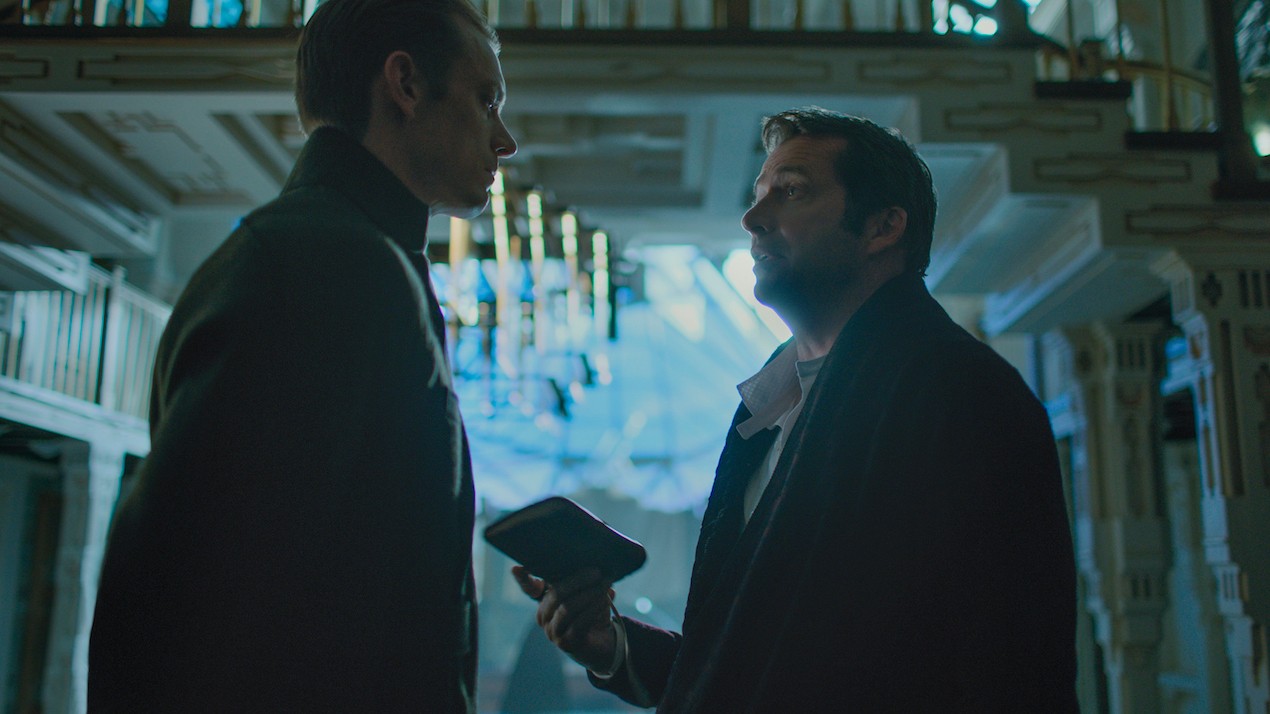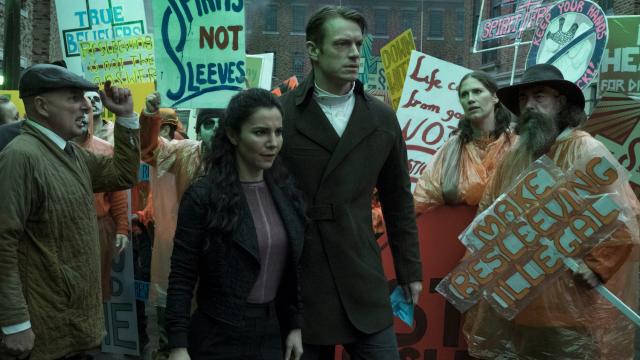Netflix’s Altered Carbon looks a hell of a lot like Blade Runner. That isn’t a surprise – after all, Blade Runner is the father of modern cyberpunk. But Altered Carbon is something all its own. Because in the new sci-fi series, the biggest threat to humanity isn’t artificial intelligence – it’s immortality.
All Images: Netflix

I had the chance to visit the set of Netflix and Skydance’s show Altered Carbon earlier this year – an impressive experience, but not just for the eye candy. Yes, there was a giant soundstage to create the downtown slums of the future, cut off from the sun, with every surface caked in generations of poverty – along with opulent rooms for skyloft mansions and Psychasec’s steely headquarters. The sets were intricate, the costumes purposeful. But they weren’t only there to look pretty. Everything behind the show serves Altered Carbon‘s message: Humans are not meant to live forever, and immortality would be a disaster.
Based on the popular book by Richard K. Morgan, Altered Carbon is about an ex-soldier named Takeshi Kovacs (Joel Kinnaman) who’s been tasked with solving the murder of multi-billionaire Laurens Bancroft (James Purefoy). But here’s the rub: Bancroft is the one who hired him. This is because Altered Carbon takes place hundreds of years after scientists digitised the human consciousness. People are placed into small storage discs, called “stacks”, and can freely be moved between bodies, which are now referred to as “sleeves”. There are people who refuse to stack themselves for religious reasons, but most are eager for as much time as they can get. Thanks to this technology, Bancroft has been around for over 300 years, and could conceivably live forever.

Bancroft (right), seen here in his study, orders Kovacs (left) to investigate his murder.
There are several questions that arise from this: Should humanity have access to immortality? What happens to someone’s mind if it never physically degrades? And, perhaps most of all, could we even call ourselves human any more? During a group roundtable, showrunner Laeta Kalogridis said the show’s digital immorality isn’t fully human, nor is it artificial intelligence – it’s posthumanism, reaching a state of being beyond humanity. She said stacking shouldn’t be called humanity as we understand it, because turning consciousness into a digital product would tear our physical and mental selves apart. It also would eviscerate our innate instincts, since they’re tied to our bodies’ need to stay alive. “Meths”, or those who can afford to live forever, would no longer care about the day-to-day struggles of a normal life – some of them might not even remember what a survival instinct felt like.
“It speaks to the idea of the posthuman thing, the idea of what we will become when we pass a certain technological threshold,” Kalogridis said. “[In Altered Carbon], we speciated ourselves to something quite different, because the biology of who you are is so violently interrupted by the idea of being able to move from one body to the next.”
It’s unclear how much the show delves into the physical and philosophical quandaries surrounding digital immortality, but it does examine what humans would actually do if they could live forever. And the answer is: More of the same. An 1890 study concluded that humans stagnate after the age of 30, a claim that subsequent studies have largely supported. Kalogridis argued that hundreds of years wouldn’t really make a difference for most people. They may have moved beyond normal living, but old habits die hard. For her, they’d most likely continue on the same path they’d always been on. In the case of a Meth such as Laurens Bancroft, played by Purefoy, that means accumulating wealth, staying in power, and getting kicks wherever he can.
“The arc of your life that you live, you know, you go up and down, dead,” Purefoy said. “[For Meths] no, up, up, up, up, and then you just keep going. What level of corruption would that bring for you?” Turns out, a lot. As Bay City PD lieutenant Kristin Ortega (Martha Higareda) says in Morgan’s book:
You live that long, things start happening to you. You get too impressed with yourself. Ends up, you think you’re God. Suddenly the little people, thirty, maybe forty years old, well, they don’t really matter anymore. You’ve seen whole societies rise and fall, and you start to feel you’re standing outside it all, and none of it really matters to you.
They’re a breed apart. They’re not human. They deal with humanity the way you and I deal with insect life.
In Altered Carbon, wealthy immortality is an amped-up version of the classism we already live with: The higher you are, the less the people below you matter. In fact, most Meths don’t view humans as worth their energy or empathy, so they treat them as disposable playthings. Physical, emotional and sexual torture is a buy-and-trade commodity, and for some pain and pleasure have become the same thing. This is actually at the heart of Altered Carbon, which comes out February 2 – showing the ugliness behind the ornate, and proving immortality isn’t something humans know what to do with.
“The Meths value their own flesh one way, and everybody else’s another,” Kalogridis concluded.

The Meths’ desire to stay above and apart from humanity really came through in the show’s design. Whether it’s the costumes, where Meths are draped in soft white fabrics to represent their godlike status, or the fact that they literally live above the clouds, with their homes using the slums as building foundation. Production designer Carey Meyer (Firefly) said there were two distinct looks created for the Meth environments, to represent their opulence. For places such as the Psychasec headquarters, everything was concrete and glass. Typical 2010s sci-fi. However, Bancroft’s home is more Art Deco. This was partially modelled after the Tyrell Corporation in Blade Runner, but Meyer said it’s also because the period encapsulates what the Meths are, old luxury being adapted for modern times.
However, don’t let the beauty fool you. In Bancroft’s study, there’s a pond filled with koi fish. As shown by a scene that was filmed but not used (according to Meyer), the fish contain the minds of enslaved humans. Trapped as helpless creatures, existing only as decoration, forever at the mercy of a higher being.
